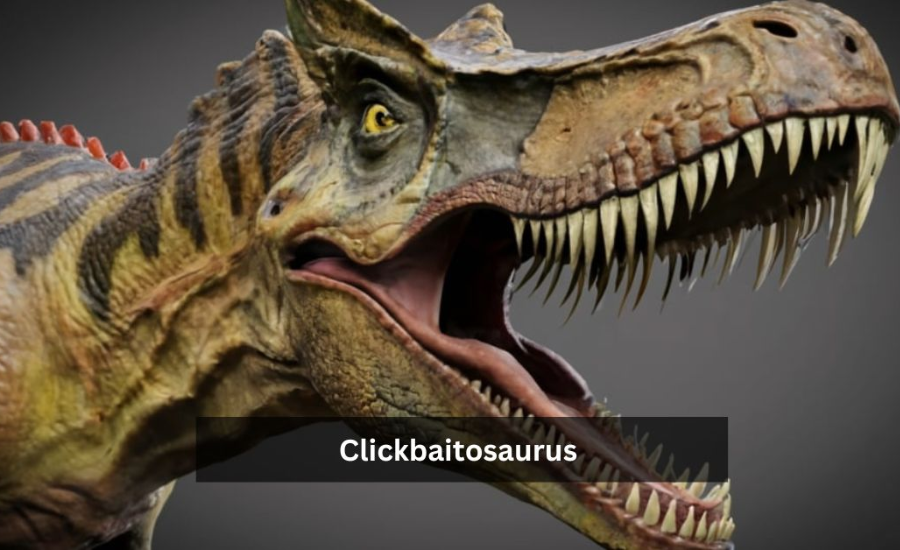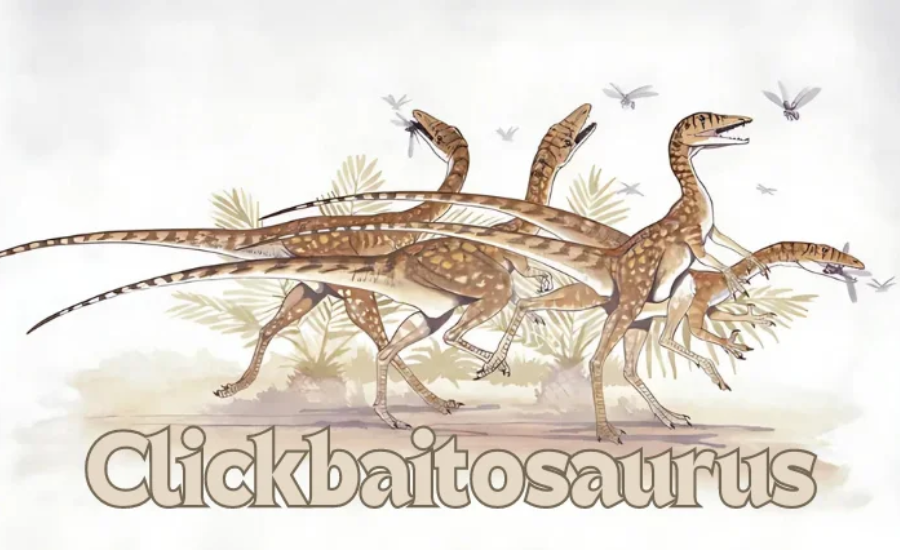Clickbaitosaurus: The Digital Era’s Master of Online Content
Have you ever found yourself irresistibly drawn to a headline on your social media feed, unable to resist the urge to click? You’ve just encountered a prime example of what some call the “clickbaitosaurus,” a phenomenon that has become a dominant force in the realm of online content. This digital beast thrives by enticing users with bold claims and sensational promises, from astonishing revelations to transformative life hacks, all designed to capture your attention in a crowded digital landscape.
So, where did this compelling tactic originate, and how did it become such a powerful tool in online media? In an era where people’s attention spans are dwindling rapidly, the clickbaitosaurus has adapted and evolved to remain at the forefront of digital content. By exploring its origins and the strategies that have cemented its place in the internet ecosystem, we gain insight into how it continues to engage and captivate users despite the ever-increasing competition for their attention.
Understanding the Clickbaitosaurus

The term “clickbaitosaurus” is a contemporary invention, blending the concepts of “clickbait” with “dinosaur” to describe a phenomenon that has become a staple of modern digital media. Unlike traditional scientific nomenclature, this term represents a strategic approach to online content that leverages sensationalism to capture user engagement. The clickbaitosaurus thrives on crafting irresistible headlines and tantalizing teasers designed to entice users to click, often with exaggerated promises or dramatic claims. For instance, headlines like “10 Celebrities Who Are Hiding Shocking Secrets!” or “The Next Event Will Astonish You!” are emblematic of this approach.
This strategy, while effective in attracting attention, hinges on the psychological appeal of curiosity and surprise. The clickbaitosaurus operates much like a relentless predator, drawing viewers in with the allure of uncovering hidden or extraordinary information. By using provocative language and enticing promises, these headlines seek to engage readers by playing on their natural curiosity and desire for insider knowledge or unexpected revelations.
In the landscape of online media, where competition for user attention is fierce and fleeting, the clickbaitosaurus has carved out a niche by mastering the art of grabbing and holding interest. Its effectiveness lies in its ability to exploit the digital environment’s demands for constant stimulation and quick gratification, ensuring that its headlines remain compelling and click-worthy despite the ongoing evolution of online content strategies.
Tracing the Roots of Clickbaitosaurus: How Sensationalism Evolved Online
The emergence of the clickbaitosaurus did not happen overnight but can be traced to the origins of tabloid journalism, where sensational headlines were crafted to captivate readers and boost newspaper sales. This approach, rooted in grabbing immediate attention through exaggerated or provocative statements, laid the groundwork for what would evolve into modern clickbait strategies. As the internet took off, this tradition adapted to the digital age, leading to the rise of the clickbaitosaurus—a powerful and pervasive force in online media.
In the digital landscape, the clickbaitosaurus thrives on generating clicks and engagement through increasingly outrageous and eye-catching headlines. This tactic capitalizes on the human tendency towards curiosity and the desire for instant gratification. The more sensational the content, the more successful it is at drawing users’ attention, ensuring higher click-through rates and increased visibility. This relentless pursuit of clicks has transformed digital media, turning headlines into strategic tools designed to maximize engagement.
Today, the clickbaitosaurus has found its prime habitat across a variety of platforms, including social media channels, news websites, and video thumbnails. These environments are now densely populated with such attention-grabbing tactics, reflecting a broader trend where content is crafted not only to inform but to captivate and compel immediate user interaction. This ecosystem, constantly evolving with new and inventive approaches, underscores the ongoing significance of the clickbaitosaurus in shaping digital content consumption.
The Mechanics of Clickbait: Unpacking Headlines, Hooks, and Payoffs
The Art of the Irresistible Headline
At the heart of the clickbaitosaurus strategy lies the headline—an expertly crafted element designed to captivate and compel. These headlines are meticulously crafted to pique curiosity and provoke a sense of urgency, compelling readers to click and discover what lies beyond. Phrases like “You Won’t Believe What Happened Next…” are prime examples of how these headlines use psychological triggers to engage readers. They are designed to grab attention with their sharpness and allure, making it nearly impossible for users to resist the urge to click and explore further.
The Engagement Tactic: Hooking the Reader
Once a reader is drawn in by the enticing headline, the clickbaitosaurus employs its hook to maintain engagement. This typically involves the initial content or introduction that keeps the reader interested, encouraging them to stay and explore rather than leaving the page. While the hook promises engaging content, it often delivers less than expected, creating a sense of intrigue coupled with a hint of disappointment. This tactic effectively keeps readers engaged, maintaining the clickbaitosaurus’s dominance in the digital space by balancing fascination with mild frustration.
The Reality Check: The Clickbait Payoff
The ultimate moment of truth arrives with the payoff, where the clickbaitosaurus reveals its true nature. Many times, the promised content falls short, leading readers through a maze of irrelevant ads, pop-ups, or unrelated material. The clickbaitosaurus prioritizes the quantity of clicks over the quality of content, focusing on attracting as many viewers as possible rather than providing substantial value. This approach reflects a strategic emphasis on generating high click-through rates, reinforcing the clickbaitosaurus’s role in the digital ecosystem as a master of engagement through sensationalism rather than substance.
The Clickbaitosaurus in Its Natural Habitats

Social Media: The Dense Forest of Distraction
In the vast expanse of the internet, social media stands out as a particularly dense forest where the clickbaitosaurus flourishes. Platforms such as Facebook, Twitter, and Instagram are teeming with clickbait content. These platforms are rife with viral videos, trending topics, and irresistibly provocative headlines that continually appear in users’ feeds. The clickbaitosaurus utilizes these elements to capture and hold attention, making social media a fertile ground for its tactics.
News Websites: The Clickbaitosaurus’s Prime Hunting Grounds
News websites have become another significant habitat for the clickbaitosaurus, driven by the need to attract more visitors and generate revenue through advertisements. To meet these demands, many news sites have turned to sensationalism, transforming even ordinary news stories into eye-catching headlines designed to entice clicks. If you’ve ever clicked on a news article only to find it less engaging than promised, you’ve encountered the clickbaitosaurus in action, exploiting its ability to draw readers with flashy, yet misleading, headlines.
YouTube Thumbnails: The Clickbaitosaurus’s Evolution in Video Content
In the realm of video content, the clickbaitosaurus has adapted to create a new type of bait: the clickbait thumbnail. YouTube is filled with videos that employ exaggerated thumbnails and sensational titles to attract viewers. Examples include thumbnails featuring dramatic expressions or misleadingly dramatic titles like “GONE WRONG!” or “YOU WON’T BELIEVE WHAT HAPPENS NEXT!” These features are crafted to enhance viewer interaction, highlighting the evolution of the clickbaitosaurus to excel in the current landscape of streaming and digital video.
How Clickbait Exploits Curiosity and FOMO to Capture Attention
The Power of Curiosity in Clickbait
Our tendency to fall for clickbait can be largely attributed to our innate curiosity—a fundamental trait that drives us to seek out information and solve mysteries. The clickbaitosaurus expertly taps into this psychological trait by presenting tantalizing hints that provoke our need to know more. By crafting headlines that offer a glimpse of hidden information just beyond our grasp, it effectively engages the part of our brain that thrives on uncovering secrets and satisfying our curiosity.
Fear of Missing Out: A Clickbait Strategy
Another key tactic employed by the clickbaitosaurus is leveraging the fear of missing out (FOMO). This psychological phenomenon compels individuals to stay informed about the latest trends, news, and gossip to avoid being left out of important conversations. The clickbaitosaurus capitalizes on this fear by suggesting that not clicking on its content means missing out on something significant or being excluded from a popular topic. This sense of urgency and the fear of being out of the loop encourage users to click on links to ensure they stay up-to-date with current trends and discussions.
Curiosity and FOMO: How Clickbait Exploits Our Psychology
By combining curiosity and FOMO, the clickbaitosaurus effectively manipulates our psychological responses to increase engagement. The interplay between our desire to satisfy curiosity and the fear of missing out creates a potent mix that drives us to click on sensational headlines and content. This strategic exploitation of psychological triggers ensures that the clickbaitosaurus remains a powerful force in digital media, continually drawing in users with its expertly crafted tactics.
Strategies to Outwit the Clickbaitosaurus

Identifying Clickbait Red Flags
To effectively navigate the world of clickbait, it’s crucial to learn how to identify key warning signs. Look for headlines that seem excessively dramatic or make promises that appear too good to be true. Pay attention to any sense of urgency or pressure, as these are often tactics used to provoke immediate clicks. If a headline triggers these red flags, it’s a strong indication that you might be encountering clickbait content designed to attract attention through sensationalism rather than substance.
Avoiding Clickbait: A Practical Approach
The most effective strategy to combat clickbait is to simply refrain from engaging with it. By resisting the temptation to click on flashy or misleading headlines, you help diminish the effectiveness of these tactics. Focus on seeking out content that is well-researched, informative, and presented without the use of sensationalist strategies. Developing a more critical approach to content consumption reduces the impact of clickbait and encourages the creation of higher-quality, honest media.
Leveraging Tools and Extensions
To aid in avoiding clickbait, consider utilizing various tools and browser extensions designed for this purpose. These tools can analyze headlines and flag those that exhibit clickbait characteristics, providing you with warnings before you click. Some extensions even offer alternative headlines or summaries that give you a clearer idea of the content’s quality, helping you make more informed decisions about whether to engage with the link or not.
Building Awareness and Critical Thinking
In addition to using tools and avoiding clickbait, fostering awareness and critical thinking is essential. Educate yourself about common clickbait tactics and be skeptical of headlines that seem overly sensational or manipulative. By applying critical thinking to your content consumption habits, you become less susceptible to clickbait and more adept at distinguishing between genuine and misleading information. This proactive approach not only helps you avoid clickbait but also enhances your overall media literacy.
FAQs About Clickbaitosaurus
Q1. What is clickbaitosaurus?
A. Clickbaitosaurus is a term used to describe content that uses sensational headlines to lure readers into clicking, often promising more than it delivers.
Q2. Where did clickbaitosaurus originate?
A. It evolved from sensationalist tabloid journalism, adapting to digital media with exaggerated headlines to attract online clicks.
Q3. How can I spot clickbait?
A. Look for headlines that are overly dramatic, promise too much, or create a false sense of urgency.
Q4. How do I avoid clickbait?
A. Avoid clicking on sensational headlines. Use tools or browser extensions that identify clickbait and seek out reliable, well-researched content.
Q5. How does clickbait exploit curiosity and FOMO?
A. Clickbait uses curiosity by teasing hidden information and exploits FOMO by suggesting you’ll miss out on something important if you don’t click.
Related: Why-Did-Randall-Ask-To-Buy-Altoids
Conclusion
In conclusion, the clickbaitosaurus represents a powerful strategy in digital media, capitalizing on sensationalism to capture and retain user attention. By understanding its origins and tactics—such as leveraging curiosity and fear of missing out—you can better recognize and avoid clickbait. Staying informed and critical of the content you consume, along with using tools designed to identify misleading headlines, will help you navigate the digital landscape more effectively and make more informed decisions online.
Stay connected for the latest news and exciting stories on Brain Rusher!






